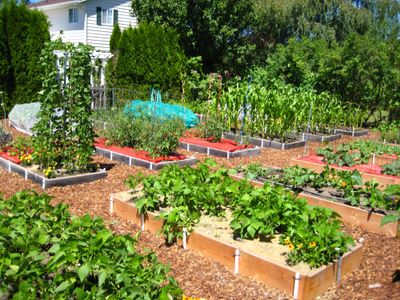Raised beds give plants reason to smile

Peter Chan is one of my gardening heroes. When the Chinese plant pathologist’s raised-bed garden was featured in a magazine in 1981, his methods immediately got my attention.
As a result, I have gardened with raised beds ever since and I am totally sold on them. Why? Put simply, it’s easier to tend raised beds.
Whether the beds are made from hilled-up soil or framed with wood, concrete blocks or bales of straw, the soil stays loose because you walk around the bed and not on the soil around the plants.
That makes plants happy because their roots won’t get compacted by foot traffic – something that really impedes a plant’s ability to take up moisture and nutrients. This also makes growing root crops like carrots and potatoes a snap since the developing vegetables can easily push down through the soil.
Because the sun hits both the sides and top of a bed, the soil warms up more quickly in the spring. This allows a gardener to get a jump on the season and plant cool-season crops earlier.
Many Inland Northwest gardeners live where the soil is mainly composed of rocks. A raised bed is an ideal solution because they can build a framed bed, add some soil and organic amendments and presto: instant garden.
If pocket gophers are a problem, hardware cloth can be stapled to the bottom of the bed to keep them out.
Framed raised beds are also easier to maintain than traditional vegetable gardens because you only have to weed the tops of the beds. I don’t know a single gardener who enjoys weeding, so that should sell you on them right there.
In my garden, the paths between the beds are covered with heavy-duty landscape fabric and about 4 inches of bark mulch, which cuts down on the weeding chores even more.
Raised beds can be any shape or length but should not be wider than you can reach across. The most common width is 3 or 4 feet. They can be any height but I’ve found 10 to 12 inches is ideal.
If you would like to build your beds with wood, choose untreated lumber. Research has shown that the chemicals used to make lumber more weather-resistant can leach into the soil and that vegetable plants can take up those chemicals. Raised beds made from untreated fir 2x10 lumber will last more than 10 years.
Another option is to build the beds with nontoxic recycled plastic lumber made from plastic milk jugs. This cuts down on the amount of plastic going to the landfills.
No matter which type of lumber you use, assemble the beds with decking screws since nails have a tendency to pop out of the joints over time.
When filling your new beds with soil, remember to add plenty of organic amendments like compost, grass clippings from an untreated lawn, composted manure or shredded leaves.
We water the plants in our raised beds with soaker hoses controlled with a timer and placed on the soil surface. This conserves water by putting it right where the plants need it and reduces evaporation.
I’ve always felt there is nothing more attractive than a well-tended vegetable garden. Since raised beds are so tidy, they are sure to make any landscape a delight to behold.